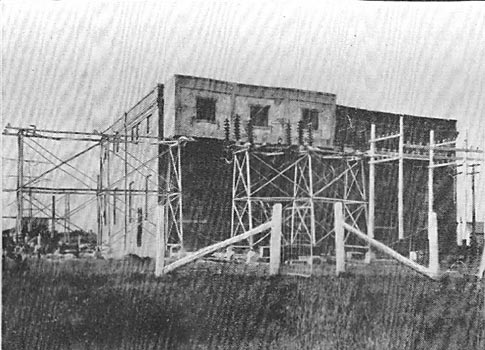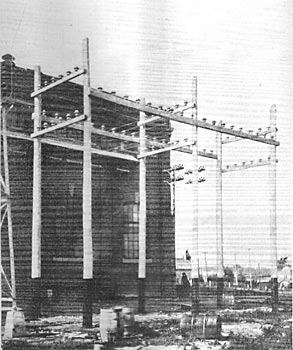[Trade Journal]
Publication: Electrical World
New York, NY, United States
vol. 54, no. 16, p. 927-931, col. 1-2
Ontario Receives Niagara Power.
To Berlin, Ont., belongs the distinction of being the first city, in the world to receive electric energy transmitted over 100 miles at a potential of 110,000 volts. The official turning on of Niagara power received over the lines of the Hydroelectric Power Commission of Ontario took place at Berlin on Oct. 11 and was followed by a three days' celebration in which the completion of the first section of the greatest public undertaking in the history of the Dominion of Canada was fittingly signalized.
Myriads of incandescent lamps were strung along the main thoroughfares, and together with electric arches and signs, transformed Berlin for the time being into an electric city. In Auditorium Rink a fine display of the most modern electrical devices, including power supplies, cooking and heating apparatus, was made by prominent Canadian and American manufacturers. This building was chiefly lighted with tungsten lamps and showed to advantage when the official button was pressed by the Premier of Ontario, Sir James Whitney, and the Hon. Adam Beck, chairman of the commission.
In the evening a banquet was given in honor of the occasion and was largely attended by electrical men from all parts of the province. A distinctive and pleasing feature of this affair was the use of electric cooking in the preparation of the different courses of the mend.
Speaking at the opening ceremonies the Hon. Adam Beck, chairman of the commission, reviewed the progress of the cheap power movement in Ontario which had led to the government undertaking the project on behalf of the people. Referring to the actual engineering and construction work, he warmly praised Chief Engineer P. W. Sothman and his staff of assistant engineers, whose services he felt had been particularly efficient. Identified with Mr. Sothman in this enterprise were the following engineers: Messrs. F. A. Gaby, chief assistant engineer ; II. G. Acres, assistant engineer in charge of hydraulic and transmission line work; E. T. J. Brandon, assistant engineer in charge of substation work; A. E. Davidson, in charge of substation construction; F. B. Manshendell, insulator expert; P. B. Yates, J. A. Brundidge and F. T. Stocking. Mr. R. A. Ross, of Messrs. Ross & liolgate, Montreal, was consulting engineer to the commission.
With a view to investigating the possibilities of obtaining cheaper electrical power a movement was started by a number of prominent manufacturers in Western Ontario and from the interest created the Hydroelectric Power Commission of Ontario came into existence. In 1905 it was incorporated by the Legislature and power was given to construct works for the transmission and supply of electrical energy.
March, 1908, saw the completion of an agreement between the commission and the Ontario Power Company, of Niagara Falls, which latter company agreed to supply up to 100,00 hp at 12,000 volts, to be paid for at the rate of $9.40 per annual horse-power for the first 25,000 hp and $9 thereafter.
Preliminary surveys were made for a transmission line taking in the cities and towns of Western Ontario which had contracted with the commission for a supply of power. It was at first the intention of the engineers to transmit the power from Niagara Falls at 60,000 volts, three-phase, and with a frequency of 25 cycles, but subsequently it was decided to raise the voltage to 110,000. In all twelve stations were constructed as follows: Step-up transformer station at Niagara. Falls; step-down station at Toronto; main interswitching station at Dundas and interswitching and transformer stations at Guelph, London, Preston, Berlin, Stratford, St. Mary's, Paris and Woodstock.
| |||
| Fig. 1 — 110,000-Volt Substation at Berlin, Ont., Can. |
On the line between Niagara and Dundas No. 4-0 stranded aluminum cable was used and No. 3-0 on the rest of the line. At Dundas the line divides into two circuits and is so arranged that in case of accident to the line at any point current can be fed around the loop in the opposite direction and the service continued without interruption. In conjunction with the power lines, which are practically double-circuited throughout, a telephone system has been installed paralleling the transmission line. The telephone line also carries a protective relay system which in the event of any lines becoming broken, grounded or short-circuited automatically cuts off the high-voltage circuit. This is effected by a balanced system of currents which become disturbed, causing a current to flow when trouble of any nature strikes the line, instantaneously disconnecting each end of the dangerous section.
In laying out their lines the engineers have paralleled the roadways as much as possible and all crossings are protected by mesh construction. The towers used in this work are of light yet substantial design and were tested thoroughly before being finally adopted by the commission. The normal span between towers on the level is 550 ft. The whole tower line is about 276 miles in length and approximately 3000 towers were required for the work of construction. At the end of the Toronto line difficulty was met in obtaining a right-of-way into the city, and as a result the engineers were forced to erect twenty towers along the waterfront and these were placed on massive concrete piers.
Providing insulators for the 110,000-volt line was no small task. Tenders were called for and manufacturers were asked to meet the most rigid specifications. The suspension type of insulator was adopted and these were required to withstand a dry potential test of 330,000 volts and a wet test of 220,000 volts, with in. of rain per minute at 45 deg. angle toward the insulator. The strain insulators, used on all angles, transpositions and long spans, were compelled to withstand 10,000 lb. without breaking. The first contract for insulators was placed with the Ohio Brass Company, but some of the later insulators were purchased in Germany.
| |||
| Fig. 2 — 110,000-Volt Substation at Berlin, Ont., Can. — Outgoing Lines |
The contract for the construction and erection of the high-tension line was awarded to the F. H. McGuigan Construction Company, which was the lowest tenderer and which agreed to build the line according to specifications and to supply all the materials except insulators. The contract price was [dollar: $1,270,000] and called for the execution of the work not later than July, 1910. Unfortunately there have been delays in supply of materials and on questions of right-of-way which have made impossible the completion of the line by the date set. The contracts for the electrical equipment for the different stations were let early in 1909. On account of the pioneer nature of the work it was deemed advisable to consult with several of the prominent power transmission engineers before awarding contracts, and the services of Messrs. R. A. Ross, V. G. Converse and Ralph D. Mershon were accordingly obtained. Visits were made to the works of the companies tendering for the supply of equipment, and contracts were finally made with the Canadian General Electric Company for the supply and installation of the necessary equipment for the stations at Toronto, London, Guelph, Preston, Berlin, Stratford, St. Mary's, Woodstock and St. Thomas, with the exception of the 110,000-volt line switches, which were supplied by the Canadian Westinghouse Company in the above-mentioned stations. This company also supplied the complete equipment of the Niagara and Dundas stations, and installed the protective relay system to cut out automatically defective portions of the line without disconnecting the supply of power at any distributing point of the system.
During the summer of 1909 Chief Engineer Sothman and one of his assistant engineers visited Europe for the purpose of collecting data and latest information on European practice in construction and equipment of high-tension power transmission lines. They also studied the conditions abroad pertaining to the general use of electric power appliances and machinery which eventually could be introduced to further the more general adoption of electric power in the Province. On this trip information of a most valuable character was collected and tabulated.
In conclusion, it may be pointed out that the work of the Hydroelectric Power Commission of Ontario extends over a wide area. The completion of the lines in Western Ontario will soon be an accomplished fact. Other parts of the Province are, however, clamoring for the commission's supervision of water-powers. Already the Hydraulic Department has estimated the water-power resources of the Province, storage areas have been surveyed and reported on, and in the case of Dog Lake, situated in the northern part of the Province, plans for increased storage capacity have been drawn for the Department of Public Works and construction work placed under way. In the east, Ottawa, the Canadian capital, is securing a power supply at a comparatively low rate through the interests of the commission, while many other towns are making application for a similar service.


